SSZTAR5 october 2016 TPS54326 , TPS561201 , TPS562201 , TPS563201 , TPS563240 , TPS563249 , TPS564201 , TPS565208
Keeping DC/DC Solutions (Super) Simple for Cost-sensitive Applications
Have you recently upgraded your TV to one with a larger screen and ultra-high-definition resolution? Have you installed a new set-top box with six-channel simultaneous digital video recording? Does your modem enable 200 Mbps Wi-Fi speeds? Can you control your home air-conditioning unit or car ignition with your smartphone?
Technology is indeed moving very fast, and behind the curtain, continuous innovation toward better performance, novel features and sleeker designs are the foundation behind the development of next-generation consumer devices.
For example, I have been amazed with the new generation of digital TVs and how the major brands continue to release models with higher image resolutions, sleeker designs and bigger screen sizes. They are now talking about 8K HD by 2020. On top of that, the leading manufacturers have dropped pricing significantly over the past 10 years, despite improving features and performance over previous models.
This is also true for DC/DC power solutions for consumer electronics. There is a demand for technology and innovation. And new DC/DC solutions like the TPS562201, TPS563201 and TPS564201 are smaller and simpler, but have higher efficiency to reduce power consumption and meet market needs.
Better Efficiency
Through a recent advancement in package technology called flip-chip on lead (FCOL), TI can now manufacture DC/DC converters without wire bonding. The die connects directly to the lead frame through copper bumps, which reduces the on-resistance of the MOSFET (Rdson), resulting in higher efficiency and lower power consumption.
While wire bonding for conventional packages typically requires more space due to the height and length of the wires, with FCOL the copper bumps are located beneath the die and do not require additional space, thus enabling smaller overall package sizes. See Figure 1 and Figure 2. The TPS56x201 series implements FCOL package technology.
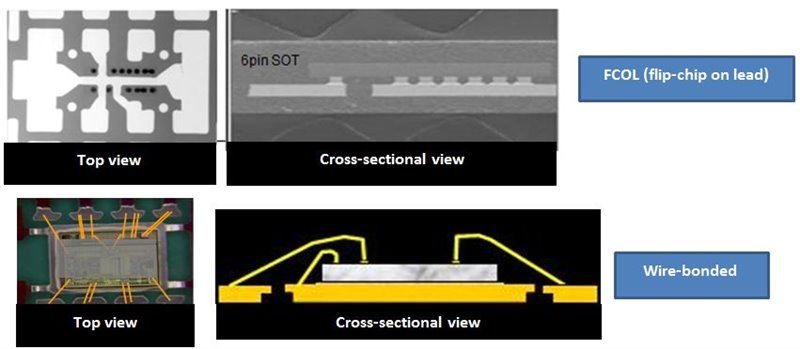 Figure 1 Flip-chip on Lead (FCOL) Compared to Conventional Wire Bonding
Figure 1 Flip-chip on Lead (FCOL) Compared to Conventional Wire BondingFor better light-load operation, the TPS56x201 family of DC/DC solutions also has much lower standby quiescent current (Iq) and implements TI’s advanced Eco-mode™ for high light-load efficiency, making it easier for designers to meet low- power standby requirements from regulatory bodies like Energy Star and the Energy-Using Products (EuP) directive. For example, a device with a 12 V to 5 V conversion at 40 mA would be able to support 90% efficiency. Refer to Figure 2 for 3 A TPS563201 and 4 A TPS564201 efficiency curves.
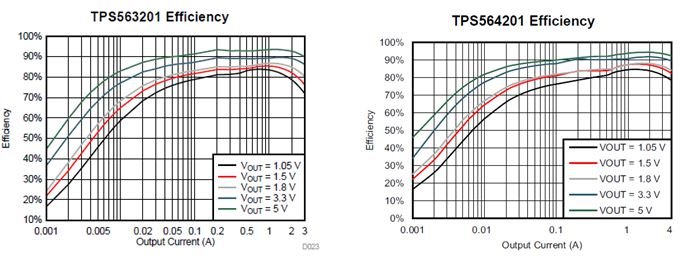 Figure 2 TPS563201 and TPS564201 Efficiency Curves
Figure 2 TPS563201 and TPS564201 Efficiency CurvesSmaller PCB Size
The earlier-generation TPS54326 device has been popular in consumer applications. This device is offered in a simple small-outline integrated circuit (SOIC) eight-pin package and uses TI’s DCAP2™ control scheme, which provides fast transient response without the need for external phase-compensation components.
As a next-generation solution, the TPS563201 offers a much smaller small-outline transistor (SOT)23 six-pin package – three times smaller than the previous solution. The new solution also requires fewer external components and features a fixed 1 ms soft-start time, which eliminates the need for an additional capacitor for soft-start time adjustment (see Figure 3). You also won’t need a voltage regulator capacitor for internal low-dropout regulator (LDO) operation.
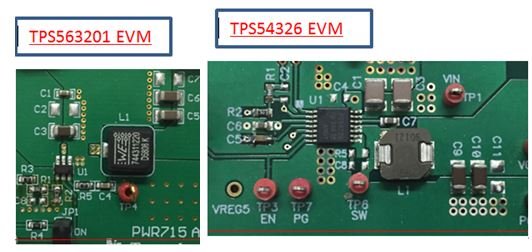 Figure 3 TPS54326 External Components Compared to TPS563201
Figure 3 TPS54326 External Components Compared to TPS563201Easy to Design
Aside for the fact that the TPS56x201 series of devices (refer to Figure 4) provide the lowest external components count with very good efficiency and very fast load transient response, the devices are also easy to use for different sockets needing a DC/DC buck converter on the board. This flexibility is due to pin-to-pin compatible between all devices and the ease with which to switch the devices on the board with minimal changes even if the load current requirement changes up to 4 A. The TPS56x201 series also provides very good light load efficiency with an advanced Eco-mode™ feature to support power consumption regulation during stand-by mode. And if this is not needed and operation at light load is preferred to be running in constant switching frequency, the TPS56x208 series would be able to cover this need as well. Refer to Figure 4 below.
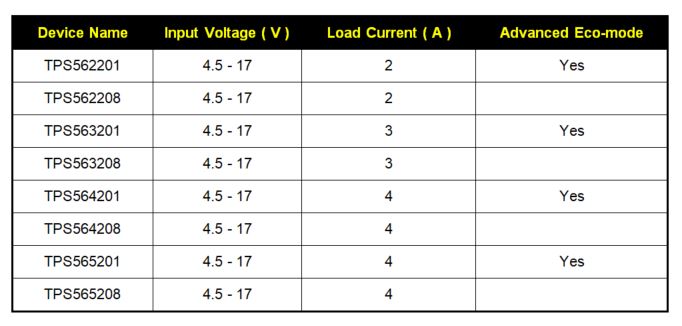 Figure 4 TPS56x201 and TPS56x208
Pin-to-pin Compatible Device Family
Figure 4 TPS56x201 and TPS56x208
Pin-to-pin Compatible Device FamilyOther Cost-sensitive Applications
Given the new devices’ ability to support simple, cost-effective and smaller solutions in consumer applications, we are also seeing the TPS56x201 implemented into Bluetooth® speakers, multifunction printers, game consoles, enterprise computing and drones. The TPS56x201 and TPS56x208 provide simple and high-efficiency solutions for 5 V, 12 V and 15 V VIN bus rails for currents as high as 4A. With the high rate of adoption for these solutions in DTV and other consumer applications like set-top-box and modems, these solutions will provide a lot of value to various end-equipment applications where efficiency, ease of use, smaller size and over-all system cost are key factors.
New High Shortwave Frequency Solution
In specific designs where PCB space is constrained, a good solution in the same device family would be TPS563240 and TPS563249. These parts operate in 1.4 MHz shortwave frequency to further reduce board space with lower output inductance required, as shown in Figure 5. TPS563240 has advanced eco-mode feature for better efficiency at light load, while TPS563249 would be operating in forced PWM. TPS563240 also has out-of audio (OOA) feature where the device would not operate below audible frequency (25 kHz).
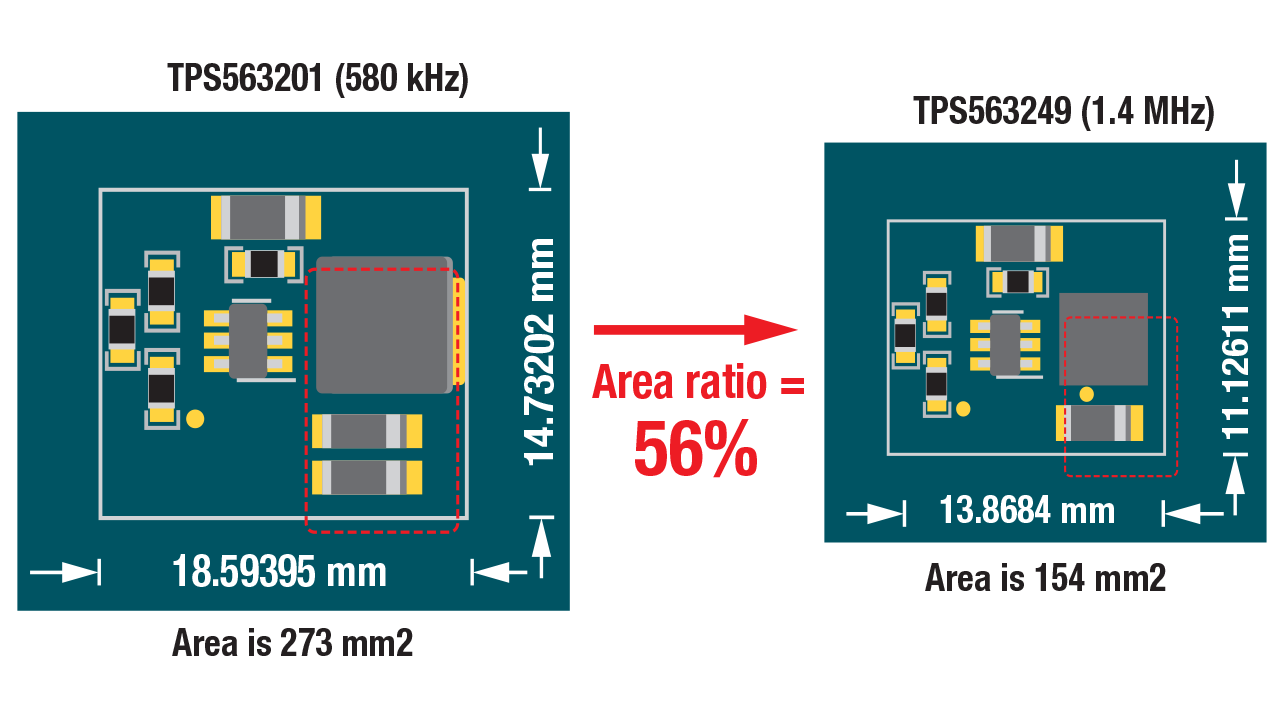 Figure 5 Board Space Reduction with TPS563420/9
Figure 5 Board Space Reduction with TPS563420/9